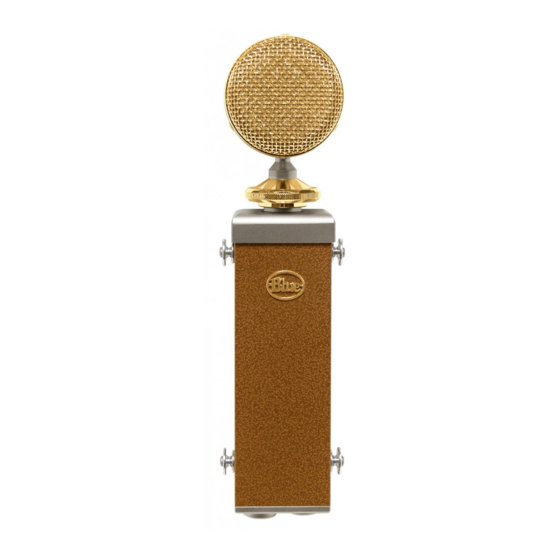Blue Cactus Manual do utilizador - Página 6
Procurar online ou descarregar pdf Manual do utilizador para Microfone Blue Cactus. Blue Cactus 6 páginas. Blue microphones cactus microphones: supplementary guide
Também para Blue Cactus: Manual do utilizador (9 páginas)

D.A. (dielectric absorption) is reluctance on the part of the capac-
itor to give up stored electrons when the capacitor is discharged.
E.S.R. (equivalent series resistance) is the resistance composed
of the capacitor plate, lead, and termination resistances. If the
capacitors used in the audio path possess high values of D.A.
and E.S.R., the result is a loss of accuracy and dynamic structure
when reproducing the finer details of the recorded source. Under
these conditions, a definite "grunge" or hashy distortion is added
to the reproduced signal. *
A special output transformer was designed by BLUE engineers to
match the tube, and to ensure complete immunity from outside
interference (RF and other sources). This hand-built transformer
is balanced, using a symmetrical two-bobbin design (i.e. hum-
bucking), with a transforming ratio of 10:1. With this ratio, the
microphone achieves a low output impedance, typically 150 ohms.
The primary transformer windings are connected in series. The
transformer's secondary windings are connected in parallel, and
connect directly to the XLR output pins. The transformer lamina-
tion has a high relative permeability, which is one of the factors
contributing to low distortion and higher dynamic range.
The tube used in the Cactus is a single subminiature pentode in
a triode mode. After being burned in for a week, this tube is hand-
selected by BLUE personnel for optimum low-noise performance.
The amplifier input is separated from the microphone capsule with
a polystyrene capacitor. Both the tube grid and the microphone
capsule are controlled through high-quality, low-noise 0.5W 400
Mohm resistors. High-end film capacitors and low-noise metal
oxide resistors are used throughout the Cactus circuit.
All of the Cactus microphone's internal wiring is oxygen-free cop-
per Teflon-insulated.
9610 Power Supply
The BLUE power supply for The Cactus microphone is based upon
our 9610 model, and features a sophisticated, regulated circuit
design as well as other features that are not available in any
other commercially available tube mic power supply. To assure
the longevity of the vacuum tube and the stability of the tube
microphone circuitry, BLUE has developed the 9610 power supply
with the new SOFT START feature.
In the past, power supplies have been designed to use both
heater and plate voltages applied simultaneously once power has
been switched on. In this case, the high voltage potential on
the plate forcefully attracts electrons from the not yet heated
cathode, a process is known as "cathode stripping". In practicali-
ty, this means that each time the power supply is switched on,
the microphone tube changes its electrical properties. To put it
simply, the tube begins to wear and gets noisier.
*For those interested in detailed description how capacitors affect the audio
circuitry, read the 1980 March & April AUDIO Magazine article by Walter
G.Jung and Richard Marsh entitled, "PICKING CAPACITORS."
9610 Power Supply
To avoid this problem the 9610's SOFT START feature delivers the
tube's heater voltage first. The 9610's circuitry also prevents the
heater current from exceeding the limits for which the tube was
designed. Without this feature the cold heater would draw more
current than specified, and begin to deteriorate the valuable
microphone tube. After approximately 80 seconds —
cathode is fully heated—
the plate voltage is gradually applied
starting from 10V to 120V (or other voltage depending on the
microphone circuitry). During this time the output of the micro-
phone is muted.
After about three minutes the tube is settled in its correct oper-
ating mode, the muting is disabled, and audio is present. Both
the heater and the plate voltages are ultra stable and non-
dependent on AC main changes or fluctuations. For AC rectifica-
tion, the 9610 uses only high frequency diodes to obtain the
purest DC possible. And most importantly, the plate voltage sup-
ply is of low impedance, which improves sonics and clarity.
9610 Pattern Select Switch
All the potentiometer switches on the 9610 are discrete military
type with enclosed contacts. The nine-position switch on the
Cactus power supply allows you to determine the pickup pattern
selection for your microphone capsule ranging from omnidirec-
tional (fully counter-clockwise) to figure of eight (fully clockwise).
9610 Metering
A custom-built meter is provided to indicate the tube strength of
the Cactus. In the upper position ("Heater") the tube filament
can be monitored. In the lower position ("Plate") the tube plate
voltage can be checked. This switch does not affect the perform-
ance of the microphone or the power supply.
9610 AC Voltage
The 9610 operates at either 110 or 240 AC voltage. Your power
supply has been set for the proper voltage required in your
country. If a voltage change is needed, push in on the fuse slot
located at the AC receptacle. Remove the fuse holder and re-
insert with the selected voltage (110 or 240) facing up.
when the
